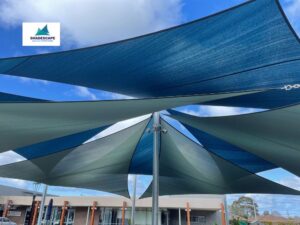Shade sails are a fashionable and convenient way to provide shade outdoors. However, how well they are installed determines how successful they are. With poor installation, you might have to deal with inadequate coverage, water pooling, and even damage to the sails or anchoring points.
At Shadescape Sails and Structures, we have an extensive team of experts who know everything about all the aspects of shade sails. They know how to deal with tensioning, anchoring, and general alignment. These factors are necessary to guarantee that your shade sails in Melbourne are installed appropriately.
Crucial Elements of Proper Shade Sail Installation
Check the Tension
For shade sails to work, tension is essential. An improperly tensioned sail can droop and collect water, which can harm the sail and its moorings. All attachment points of the shade sails should have an equal tension applied to them. Uneven tension may sag or flap in the wind, causing damage. Many sails contain turnbuckles or other adjusters that allow for fine-tuning. If the sail is too tight or too loose, adjust the tensioning system accordingly.
Check the Drop
A properly tensioned sail will have a small amount of drop at the margins to accommodate wind resistance and natural movement. Verify the consistency of the drop with a tape measure. The drop should normally be between 10% and 15% of the sail’s length.
Verify Firm Anchoring
The stability and security of your shade sails depend on proper anchoring. To make sure your anchors are secure, follow these steps. Make sure that every anchor point such as a wall, a post, or a tree is firmly and strongly fixed. Anchor points need to be strong enough to support the weight of the shade sail.
Examine All the Hardware And Fixtures
Every fastener, such as screws, bolts, and hooks, needs to be well-fastened and free of corrosion or damage. Make sure the hardware is in good condition by doing routine inspections.
Check the Load Capacity
Make sure that the hardware and anchor points are sturdy enough for the weight they will support. If in doubt, get advice from a qualified installer. Shadescape has a strong team of experts that help you deal with all your shade sails services.
Check the Angle of Installation
The angle of installation has a great impact on the look and functionality of your shade sails. It also helps for better drainage and coverage. Usually, shade sails are set at a 30 to 40-degree slant. This tilt improves air circulation underneath the sail and aids in water runoff.
Verify the Levelling
To get the appropriate angle, make sure that the corners of the sails are positioned at various heights. Check to see if the installation angle matches your design plan using a level or a laser level. The tilt of the sail has to be enough to keep water from collecting in one area. You might need to change the angle or tension if you observe a lot of sagging.
Confirm Water Runoff
Proper water outflow is necessary for the integrity of your shade sail and to avoid water damage. Keep looking for any potential pools of water. The sail should ideally be oriented to allow water to flow off and avoid pooling in low areas.
Make sure the drainage of your installation area isn’t impacted by the runoff water. You should direct the water away from any areas where it could cause issues during proper installation.
Check the Alignment
Overall alignment has an impact on both its appearance and functionality. Make sure the sail is in line with the design plan and symmetry. Alignment irregularities might affect the appearance and performance of the shade sails.
Check For Any Creases
Check the fabric for any creases or dents. The functionality of the sails might be reduced due to wrinkles, which might be an indication of incorrect tension or installation.
Evaluate Aesthetics
There should be no excessive drooping or unevenness, and the shade sail should appear smooth and taut. When installed correctly, the surface will look tidy and attractive.
Take the Weather And Wind Into Account
Rain and wind are just two of the many weather variables that shade sails need to be able to tolerate. Make sure the installation is capable of withstanding the normal wind speeds in your region. Shade sails must be able to withstand wind without flapping or moving too much.
Seasonal Modifications & Maintenance
In regions with severe weather, it is better to modify or take down the sails during storms to avoid any damage. Your shade sails may still give you problems even after they are installed correctly. You can learn more about how to maintain and clean your shade sails.
Here’s how to solve typical issues:
Sagging
Inadequate tension or improper anchoring can cause sagging of the sail. Either strengthen the anchor points or modify the tensioning.
Water Pooling
If there is water pooling in the sail, it might not be positioned correctly. To enhance the flow of water, adjust the tension or angle.
Flapping
Inadequate wind resistance or inadequate tension can lead to excessive flapping. Make sure you anchor the sail correctly and tighten the tension.
Conclusion
With proper installation, you can enjoy higher durability and functionality of your shade sails. Therefore, it is wise to trust the expertise of a professional for shade installation. It will not only save you time and money but also pay you off well in the future.






